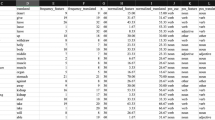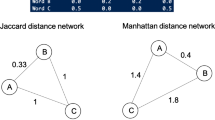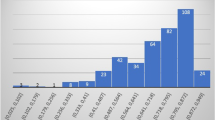Abstract
Semantic feature production norms have several desirable characteristics that have supported models of representation and processing in adults. However, several key challenges have limited the use of semantic feature norms in studies of early language acquisition. First, existing norms provide uneven and inconsistent coverage of early-acquired concepts that are typically produced and assessed in children under the age of three, which is a time of tremendous growth of early vocabulary skills. Second, it is difficult to assess the degree to which young children may be familiar with normed features derived from these adult-generated datasets. Third, it has been difficult to adopt standard methods to generate semantic network models of early noun learning. Here, we introduce Feats—a tool that was designed to make headway on these challenges by providing a database, the Language Learning and Meaning Acquisition (LLaMA) lab Noun Norms that extends a widely used set of feature norms McRae et al. Behavior Research Methods 37, 547–559, (2005) to include full coverage of noun concepts on a commonly used early vocabulary assessment. Feats includes several tools to facilitate exploration of features comprising early-acquired nouns, assess the developmental appropriateness of individual features using toddler-accessibility norms, and extract semantic network statistics for individual vocabulary profiles. We provide a tutorial overview of Feats. We additionally validate our approach by presenting an analysis of an overlapping set of concepts collected across prior and new data collection methods. Furthermore, using network graph analyses, we show that the extended set of norms provides novel, reliable results given their enhanced coverage.






Similar content being viewed by others
References
Alcock, K. J., Meints, K., Rowland, C. F., Brelsford, V., Christopher, A., & Just, J. (2020). The UK Communicative Development Inventories: Words and Gestures – Manual and Norms. J&R Press. https://www.jr-press.co.uk/uk-communicative-development-inventories.html
Andrews, M., Vigliocco, G., & Vinson, D. (2009). Integrating experiential and distributional data to learn semantic representations. Psychological Review, 116(3), 463–498. https://doi.org/10.1037/a0016261
Beckage, N., Smith, L., & Hills, T. (2011). Small worlds and semantic network growth in typical and late talkers. PloS one, 6(5), e19348.
Borovsky, A. (2022a). Lexico-semantic structure in vocabulary and its links to lexical processing in toddlerhood and language outcomes at age three. Developmental Psychology, 58(4), 607–630. https://doi.org/10.1037/dev0001291
Borovsky, A. (2022b). Drivers of lexical processing and implications for early learning. Annual Review of Developmental Psychology, 4, 21–40. https://doi.org/10.1146/annurev-devpsych-120920-042902
Borovsky, A., & Peters, R. E. (2019). Vocabulary size and structure affects real-time lexical recognition in 18-month-olds. PLoS ONE, 14(7), e0219290. https://doi.org/10.1371/journal.pone.0219290
Braginsky, M., Yurovsky, D., Marchman, V. A., & Frank, M. C. (2016). From uh-oh to tomorrow Predicting age of acquisition for early words across languages. In: Proceedings of the 38th Annual Conference of the Cognitive Science Society.
Brysbaert, M., & New, B. (2009). Moving beyond Kučera and Francis: A critical evaluation of current word frequency norms and the introduction of a new and improved word frequency measure for American English. Behavior Research Methods, 41(4), 977–990.
Brysbaert, M., New, B., & Keuleers, E. (2012). Adding part-of-speech information to the SUBTLEX-US word frequencies. Behavior Research Methods, 44(4), 991–997.
Buchanan, E. M., Valentine, K. D., & Maxwell, N. P. (2019). English semantic feature production norms: An extended database of 4436 concepts. Behavior Research Methods, 51, 1849–1863. https://doi.org/10.3758/s13428-019-01243-z
Collins, A. M., & Loftus, E. F. (1975). A spreading-activation theory of semantic processing. Psychological Review, 82, 407–428.
Cox, C. R., & Haebig, E. (2023). Child-oriented word associations improve models of early word learning. Behavior Research Methods, 55, 16–37. https://doi.org/10.3758/s13428-022-01790-y
Cree, G. S., & McRae, K. (2003). Analyzing the factors underlying the structure and computation of the meaning of chipmunk, cherry, chisel, cheese, and cello (and many other such concrete nouns). Journal of Experimental Psychology: General, 132(2), 163.
Cree, G. S., McRae, K., & McNorgan, C. (1999). An attractor model of lexical conceptual processing: Simulating semantic priming. Cognitive Science, 23(3), 371–414.
Davis, C. J. (2005). N-Watch: A program for deriving neighborhood size and other psycholinguisticstatistics. Behavior Research Methods, 37, 65–70. https://doi.org/10.3758/BF03206399
Devereux, B. J., Tyler, L. K., Geertzen, J., & Randall, B. (2014). The Centre for Speech, Language and the Brain (CSLB) concept property norms. Behavior Research Methods, 46(4), 1119–1127.
Engelthaler, T., Hills, T. T. (2016). Feature biases in early word learning: network distinctiveness predicts age of acquisition. Cognitive science.
Fenson, L., Marchman, V. A., Thal, D. J., Dale, P. S., & Reznick, J. S. (2007). MacArthur-Bates communicative development inventories (2nd ed.). Baltimore: Paul H. Brookes.
Frank, M. C., Braginsky, M., Yurovsky, D., & Marchman, V. A. (2017). Wordbank: An open repository for developmental vocabulary data. Journal of Child Language, 44(3), 677–694.
Garrard, P., Lambon Ralph, M. A., Hodges, J. R., & Patterson, K. (2001). Prototypicality, distinctiveness, and intercorrelation: Analyses of the semantic attributes of living and nonliving concepts. Cognitive Neuropsychology, 18(2), 125–174.
Grondin, R., Lupker, S. J., & McRae, K. (2009). Shared features dominate semantic richness effects for concrete concepts. Journal of Memory and Language, 60(1), 1–19.
Hills, T. T., Maouene, M., Maouene, J., Sheya, A., & Smith, L. (2009). Longitudinal analysis of early semantic networks preferential attachment or preferential acquisition? Psychological Science, 20(6), 729–739.
Hills, T. T., Maouene, M., Maouene, J., Sheya, A., & Smith, L. (2009). Categorical structure among shared features in networks of early-learned nouns. Cognition, 112(3), 381–396.
Hills, T. T., Maouene, J., Riordan, B., & Smith, L. B. (2010). The Associative Structure of Language: Contextual Diversity in Early Word Learning. Journal of Memory and Language, 63(3), 259–273. https://doi.org/10.1016/j.jml.2010.06.002
Hintzman, D. L. (1986). "Schema abstraction" in a multiple-trace memory model. Psychological Review, 93(4), 411–428. https://doi.org/10.1037/0033-295X.93.4.411
Inhelder, B., & Piaget, J. (1964). The growth of logic in the child. Routledge & Paul.
Kuperman, V., Stadthagen-Gonzalez, H., & Brysbaert, M. (2012). Age-of-acquisition ratings for 30,000 English words. Behavior Research Methods, 44, 978–990.
Lenci, A., Baroni, M., Cazzolli, G., & Marotta, G. (2013). BLIND: A set of semantic feature norms from the congenitally blind. Behavior Research Methods, 45(4), 1218–1233.
MacWhinney, B. (2000). The CHILDES project: Tools for analyzing talk (3rd ed.). Lawrence Erlbaum Associates.
Mahon, B. Z., & Caramazza, A. (2009). Concepts and categories: a cognitive neuropsychological perspective. Annual Review of Psychology, 60, 27.
Martin, A. (2007). The representation of object concepts in the brain. Annual Review of Psychology, 58, 25–45. https://doi.org/10.1146/annurev.psych.57.102904.190143
McRae, K., Cree, G. S., Seidenberg, M. S., & McNorgan, C. (2005). Semantic feature production norms for a large set of living and nonliving things. Behavior Research Methods, 37(4), 547–559.
Medin, D. L., & Schaffer, M. M. (1978). Context theory of classification learning. Psychological Review, 85, 207–238.
Minda, J. P., & Smith, J. D. (2002). Comparing prototype-based and exemplar-based accounts of category learning and attentional allocation. Journal of Experimental Psychology: Learning, Memory, and Cognition, 28(2), 275–292. https://doi.org/10.1037/0278-7393.28.2.275
Muraki, E. J., Sidhu, D. M., & Pexman, P. M. (2020). Mapping semantic space: property norms and semantic richness. Cognitive Processes, 21, 637–649. https://doi.org/10.1007/s10339-019-00933-y
Murdock, B. B. (1982). A theory for the storage and retrieval of item and associative information. Psychological Review, 89(6), 609.
Peters, R. E., & Borovsky, A. (2019). Modeling Early Lexico-Semantic Network Development: Perceptual Features Matter Most. Journal of Experimental Psychology: General, 148(4), 763–782.
Pexman, P. M., Lupker, S. J., & Hino, Y. (2002). The impact of feedback semantics in visual word recognition: Number-of-features effects in lexical decision and naming tasks. Psychonomic Bulletin & Review, 9(3), 542–549.
Pexman, P. M., Hargreaves, I. S., Siakaluk, P. D., Bodner, G. E., & Pope, J. (2008). There are many ways to be rich: Effects of three measures of semantic richness on visual word recognition. Psychonomic Bulletin & Review, 15(1), 161–167.
Quinn, P. C., & Eimas, P. D. (1997). A reexamination of the perceptual-to-conceptual shift in mental representations. Review of General Psychology, 1(3), 271.
Quinn, P. C., & Eimas, P. D. (2000). The emergence of category representations during infancy: Are separate perceptual and conceptual processes required? Journal of Cognition and Development, 1(1), 55–61.
Rabovsky, M., & McRae, K. (2014). Simulating the N400 ERP component as semantic network error: Insights from a feature-based connectionist attractor model of word meaning. Cognition, 132(1), 68–89.
Rakison, D. H., & Oakes, L. M. (Eds.). (2003). Early category and concept development: Making sense of the blooming, buzzing confusion. Oxford University Press.
Rogers, T. T., & McClelland, J. L. (2004). Semantic cognition: A parallel distributed processing approach. MIT Press.
Sanchez, A., Meylan, S. C., Braginsky, M., MacDonald, K. E., Yurovsky, D., & Frank, M. C. (2019). childes-db: A flexible and reproducible interface to the child language data exchange system. Behavior Research Methods, 51, 1928–1941. https://doi.org/10.3758/s13428-018-1176-7
Smiley, S. S., & Brown, A. L. (1979). Conceptual preference for thematic or taxonomic relations: A nonmonotonic age trend from preschool to old age. Journal of Experimental Child Psychology, 28(2), 249–257.
Smith, E. E., & Medin, D. L. (1981). Categories and concepts. Harvard University Press.
Stella, M., Beckage, N., & Brede, M. (2017). Multiplex lexical networks reveal patterns in early word acquisition in children. Scientific Reports, 7, 46730. https://doi.org/10.1038/srep46730
Vinson, D. P., & Vigliocco, G. (2008). Semantic feature production norms for a large set of objects and events. Behavior Research Methods, 40(1), 183–190.
Wu, L. L., & Barsalou, L. W. (2009). Perceptual simulation in conceptual combination: Evidence from property generation. Acta Psychologica, 132(2), 173–189.
Yurovsky, D., Bion, R., Smith, L., Fernald, A. (2012). Mutual Exclusivity and Vocabulary Development. In: Proceedings of the Cognitive Science Society (vol. 34, No. 34).
Acknowledgements
This work was supported by grants from the NIH (R03DC013638, R01DC018593 awarded to AB, and F31DC017089 to REP) and NSERC (Discovery Grant 05652 to KM). It would not have been possible without the research assistants (Emanuel Boutzoukas, Sofia Castillo, Ireney Duval, Stacey Hanson and Kathleen Hopkins) who contributed to this effort.
Author information
Authors and Affiliations
Corresponding author
Additional information
Publisher's Note
Springer Nature remains neutral with regard to jurisdictional claims in published maps and institutional affiliations.
Open Practices Statement
The Feats datasets is available upon publication at https://osf.io/7d8et/
Appendices
Appendix 1: Instructions for Feature Production Norms
Instructions (please read carefully)
This experiment is part of an investigation into how people read words for meaning. To help us conduct this work, we need information on what people know about different things in the world. On the following pages, there are words that each denote a concept, with each being followed by 14 blank lines. Please fill in as many of these lines as you can with properties of the concept to which the word refers. Examples of different types of properties would be: physical properties, such as internal and external parts, and how it looks, sounds, smells, feels, or tastes; functional properties, such as what it is used for; where, when and by whom it is used; things that the concept is related to, such as the category that it belongs in; and other facts, such as how it behaves, or where it comes from. Please note that even though many of the words can be thought of as something other than a noun (e.g., “camp” can refer to the place where your tent is pitched, or the action of camping), all words on the following pages are meant to be considered as nouns only (e.g., “camp,” the place). Below, we have provided 3 examples to give you an idea of what might be considered a property description of a concept.
duck | cucumber | balloon |
|---|---|---|
is a bird | is a vegetable | different colors |
is an animal | has green skin | bursts |
waddles | has a white inside | expands |
flies | has seeds inside | floats |
lays eggs | is cylindrical | produces a loud noise when popped |
quacks | is long | is colorful |
swims | grows in gardens | is large |
has wings | grows on vines | is lightweight |
has a beak | is edible | is round |
has webbed feet | is crunchy | made of plastic |
has feathers | used for making pickles | made of rubber |
lives in ponds | eaten in salads | requires air |
lives in water | used at parties | |
hunted by people | used by children | |
is edible | used by clowns |
You may be able to think of more and/or different types of properties for these concepts, but these examples should give you an idea of what is requested of you. Please do not languish an extraordinary amount of time on each word, but also please take a bit of time to consider the relevant properties of each entity or object. In other words, complete this questionnaire reasonably quickly, but keep the relevant types of properties in mind. Thank you very much for completing this questionnaire.
Appendix 2
Appendix 3: List of re-normed concepts
The following 31 concepts were re-normed as part of this study to determine whether our data collection procedures yielded similar data to that captured in the McRae et al., (2005) norms.
alligator | elephant | rocker |
|---|---|---|
ball | grape | shoes |
bike | house | sink |
bin_(waste) | key | slippers |
boat | lamb | socks |
book | motorcycle | stick |
car | orange | stove |
church | pajamas | tractor |
crayon | peas | truck |
doll | potato | |
dress | rock |
Appendix 4: Instructions for Feature Toddler-Accessibility Rating Norms
Instructions (please read carefully):
We are interested in understanding how people learn about features of real world objects. For example, how do children learn that something like a POLAR BEAR can be described by features like: <is white>, <has fur>, <an animal>, <is large>, and <lives in the Arctic>. The features that we learn depend on experiences built over a lifetime. Sometimes, the features that young children know about objects can be very different from adults' understanding of these same items.
The purpose of this experiment is to rate features as to how likely they are to be part of what a toddler understands about the world. For example, the feature <is white> is likely to be accessible to a toddler (even if they don't know the word "white"), while a feature like <lives in the Arctic> is a feature that a toddler probably has not come across and would not yet understand.
Your ratings of how likely a feature is understood by toddlers will be made on a 1 to 7 scale. A value of 1 will indicate that a feature is very unlikely to be part of a toddler’s knowledge, and a value of 7 will indicate that a feature is very likely to be part of a toddler’s knowledge. Values 2 to 6 will indicate intermediate ratings.
In the example above, <is white> would be given a score of very likely to be part of a toddler’s knowledge, but <lives in the Arctic> would be given a score of very unlikely to be part of a toddler’s knowledge.
We will also provide some examples of different words that go with each feature, to give you a concrete idea of how it is relevant. A toddler may not know all or even most of the examples, but do not take this into account when making your rating. Instead, simply focus on how likely the feature is to be a part of a toddler's knowledge, assuming they were familiar with the examples.
Please feel free to use the whole range of values provided when making your ratings. Mark the rating that is most appropriate for each feature. When making your ratings, try to be as accurate as possible, but do not spend too much time on any one feature.

Appendix 5
Appendix 6
Appendix 7
Rights and permissions
Springer Nature or its licensor (e.g. a society or other partner) holds exclusive rights to this article under a publishing agreement with the author(s) or other rightsholder(s); author self-archiving of the accepted manuscript version of this article is solely governed by the terms of such publishing agreement and applicable law.
About this article
Cite this article
Borovsky, A., Peters, R.E., Cox, J.I. et al. Feats: A database of semantic features for early produced noun concepts. Behav Res (2023). https://doi.org/10.3758/s13428-023-02242-x
Accepted:
Published:
DOI: https://doi.org/10.3758/s13428-023-02242-x




